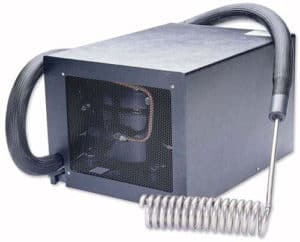Chillers are one of those things only the Pro’s or huge aquariums need correct? Nope! Any aquarium is susceptible to temperature fluctuations and in fact, the smaller the aquarium, the faster those fluctuations happen.
I never thought I would need a chiller and then I moved across the country where the summers get hot and boy did I start to worry when my house was starting to heat up! Oh, and I have house AC but my wife didn’t want it running 24/7 from June to September! So what was the only option left…? Install an Aquarium Chiller
Aquarium chillers are small, refrigerator-type devices that install into an aquarium system. It monitors and automatically cools the water temperature if it begins to rise. Used in conjunction with an aquarium heater, the temperature of an aquarium will remain absolutely stable.
Chillers are not a cheap device but if you can find a good one second-hand or are thinking about installing one then this article is going to tell you exactly what they do and why you really need one.
Why Do You Need An Aquarium Chiller?
We all have a heater in our aquariums to keep the temperature around 78-80°F but what happens in summer when the ambient heat of your house begins to rise?
Due to conduction and convection, the water in your aquarium will begin to rise as a result of its surroundings. Increasing water temperatures bring with it several problems that can have catastrophic effects:
Oxygen Reduction
As the temperature of a body of water increases its ability to hold oxygen within it begins to reduce. The warmer the water the less oxygen it holds.
This presents the first problem to our aquariums because of the closed eco-system we have built in our home. There are many inhabitants that consume oxygen on our aquarium and they are:
- Fish
- Crabs
- Snails
- Shrimp
- Corals
- Bacteria
- Algae
- Copepods & Micro Fauna
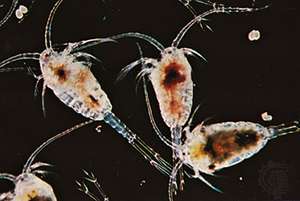
You may not think that the oxygen will begin to reduce but when your water heats up and if you have a heavily stocked aquarium, the oxygen consumption from these organisms can soon catch up with the amount saturated within the water.
Bacteria Die-Off
The Nitrifying Bacteria that live all over your aquarium are the biological filter in your aquarium. They help to process the toxic compounds like Ammonia and Nitrite into the less harmful Nitrate and Nitrogen.
These bacteria are suited to living in the same temperature range as the rest of the inhabitants in your aquarium. As the water temperature increases, this bacteria will begin to die.
The more that die, the less waste they process and your water soon becomes polluted. The other problem with them dying is that they will decay and release Ammonia, Nitrate, and Phosphate into the water, thus making the water pollute even faster.
Stress-Induced Illness
Fish are a cold-blooded organism. This means they have no way of controlling their body heat. They rely completely on their surrounding environment for their survival.
When they heat up they get stressed, and just like humans, when you get stressed it puts a strain on the body’s immune system which can leave it vulnerable to attack from parasites, diseases, and bacteria.
There is also illness-causing organisms living in our aquariums that are dormant below certain temperatures. As the water temperature approaches their ideal range, they can begin to reproduce and attack your livestock.
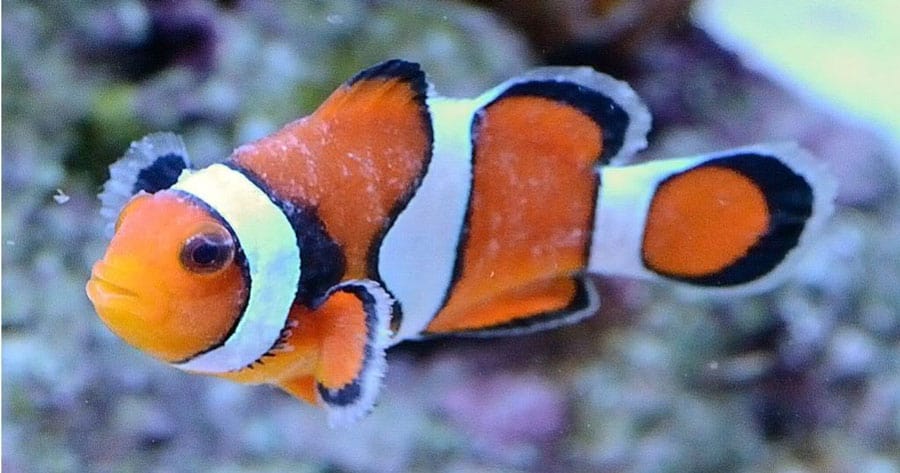
You now have stressed fish with compromised immune systems and now you have extra organisms trying to attack them. It’s just a recipe for mass fatalities within your aquarium.
Algae Blooms
Have you ever wondered why lakes and ponds turn green in summer and not in winter? Its because algae cells rapidly reproduce in warmer temperatures. As your aquarium water heats up the reproduction of algae-based cells increases and you could notice your tank turning green rather quickly.
Apart from your once pristine aquarium turning green you now have the problem of more algae cells consuming the ever decreasing oxygen from your water.
If you look at all of the problems listed above and imagine them all happening at once you can instantly see that your aquarium can go south very fast once the water reaches a point of no return. A simple way to prevent this happening is to install a Set-&-Forget Aquarium Chiller.
Are There Different Types Of Aquarium Chiller?
There are several types of commercially made chillers. Each chiller is made to cool a given volume of water and selecting one that best suits your needs is a simple process depending on how you need to install it.
For a real in-depth analysis of all the types of chiller, how to select one and how to size one you can follow the link to my article ‘What Size Chiller Do Do I Need For My Aquarium‘ at the end of this article.
Nano-Chillers
Just as the name suggests. These are chillers designed for nano-aquariums up to 30 gallons. There are two types. An inline version requires a pump to move water from the aquarium, through the chiller and back or a probe-type that sits in the aquarium and cools the water in contact with it.
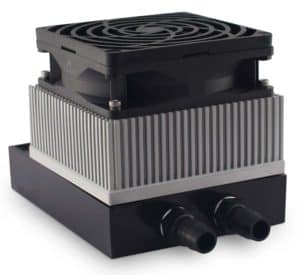
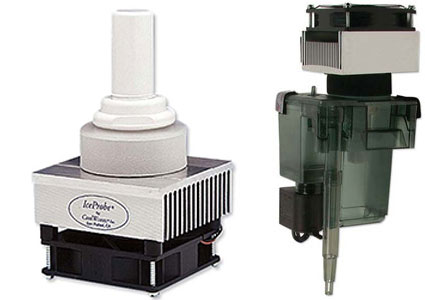
Inline Chillers
These are by far the most popular chiller on the market. They come in a range of sizes to suit aquariums from 30 gallons to +1200 gallons! They are usually situated next to the aquarium and water is fed through them via a pump or they are fed off a manifold.
Water is circulated through them and when they detect the water is getting too warm, they automatically switch on and cool the water to bring in back down to the set temp, then turn off and wait.
Submerged Coil Chillers
When you need to have a large chiller but you don’t have space next to the sump or no space to install a feed pump, these chillers are a great option. They have the pump and controls all built into the unit and the Titanium coil sits in an area within the sump or aquarium.
Just like the inline chillers these are set and forget units that automatically switch on and off to maintain the set water temperature.
How Does An Aquarium Chiller Work?
Nano-Chillers
For the small Nano-Chillers they use a cooling technology called Peltier Effect (Wiki Link) to cool a heatsink. Peltier conductors work by passing an electric current through a special laminate sandwich. One side heats up, the other side cools down.
The side that cools down is attached to a heatsink which the water pipe runs through or the titanium probe is attached to. The hot side of the Peltier plate is attached to another heatsink with a fan on top to draw the heat out and disperse it into the air.
Larger Chillers
The larger chillers, both inline and submerged coil use the same principle as your home refrigerator as described below:
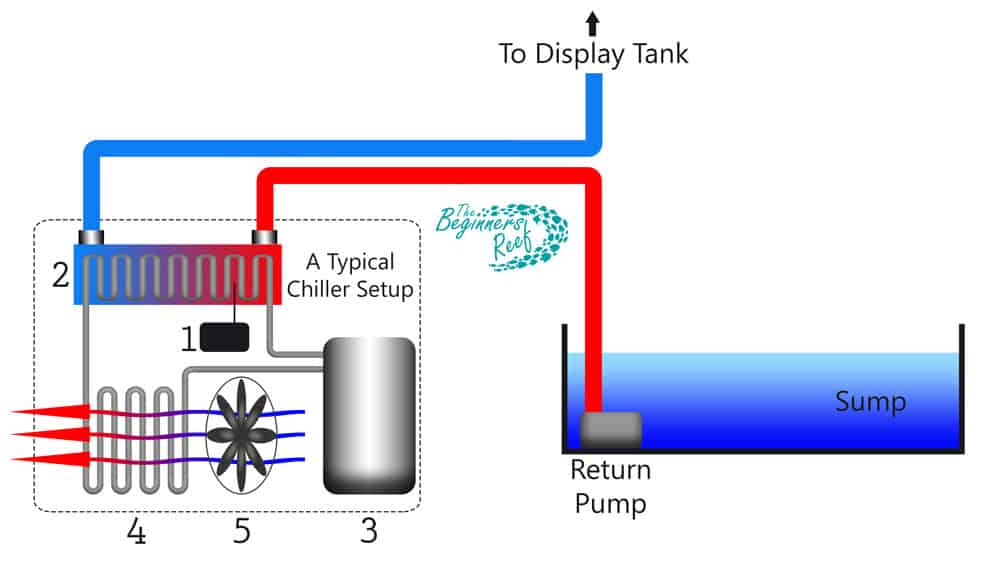
1. Temperature Controller
This electronic unit uses a temperature probe to monitor the temperature of the water flowing into the chiller. As the water temperature rises above the setpoint set by the owner (say 81°F) this will activate the chiller system to turn on and cool the water back down below the set temperature.
Once the temperature drops below the setpoint of 81°F it will turn the chiller off and wait until the temperature rises again.
2. Heat Exchanger
The heat exchanger does exactly what it sounds like. It exchanges or transfers heat from the aquarium water into the refrigerant liquid contained within the chiller system.
It is a sealed unit with a titanium (on the quality models!) coil inside it. The aquarium water runs around the outside of the coil while the refrigerant liquid flows through the inside of the coil. The water and the refrigerant never mix.
3. Compressor
As the now warm refrigerant liquid leaves the heat exchanger it enters the compressor where it is compressed which turns it into a gas. This compression also moves the gas/liquid around the chiller system.
4. Condensor
Compressed gas now flows to the condenser where the pressure is dropped and the gas turns back into a liquid state. As the pressure drops the liquid movies through another type of heat exchanger with hundreds of heat dissipating fins all over it. This looks identical to the radiator in your car.
As the gas turns back into a liquid it releases the heat contained within it, thus transferring the heat into the heat dissipating fins, which then transfer that heat into the surrounding air.
The cooled liquid refrigerant now flows back to the heat exchanger to repeat the cycle.
5. Cooling Fan
The cooling fan is used to move a large volume of air over the heat dissipating fins of the condenser. This helps heat removal from the liquid refrigerant and move the warm air away from the chiller unit to keep it working as efficiently as possible,
To Finish
An aquarium chiller is an expensive piece of equipment but yet can be a vital one if you live in a warm climate. The problems caused by fluctuating water temperature can not only harm your livestock but can drive you absolutely nuts trying to figure out why you are always getting problems.
I was lucky and managed to find my chiller, used, off an aquarist that was leaving the hobby and it has been the best $100 I have ever spent! Keep your eyes open for those bargains as you will never regret installing a chiller on your aquarium!
For a Great Selection of Aquarium Chillers, More Information and Latest Pricing I Recommend You Check Them Out
HERE at AquariumSpecialty.com
Further Reading
The next article I really advise you to read is the follow-on from this article:


